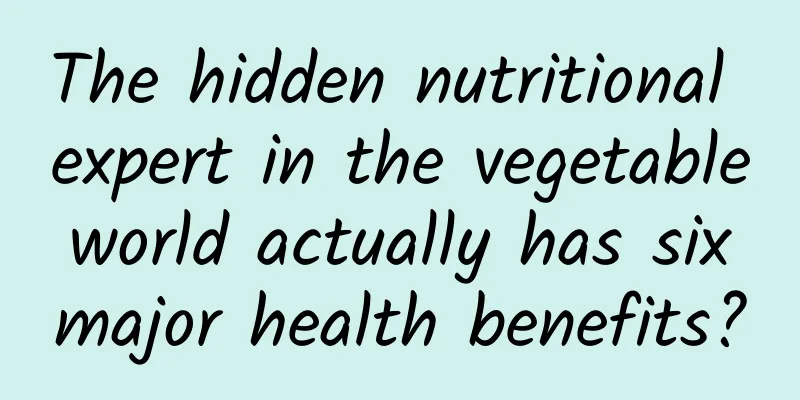The hidden nutritional expert in the vegetable world actually has six major health benefits?

|
There is a class of vegetables that can be called the "Hermes" of vegetables. They are highly praised by various healthy eating guidelines around the world. They are easy to cook and high-end. In recent years, more and more studies have confirmed the various benefits of this class of vegetables, including the presence of many antioxidants, nutrients and sulfur compounds. These are cruciferous vegetables, including broccoli, cauliflower, cabbage, choy sum, radish, purple cabbage, kohlrabi, arugula, kale, etc. Eating raw food is more nutritious than eating cooked food Cruciferous vegetables are rich in dietary fiber, vitamin A, vitamin K, vitamin C, potassium and phytochemicals, especially sulfur-containing compounds such as glucosinolates. Brassica glucosinolate is a type of glucosinolate in cruciferous vegetables. It undergoes a series of metabolic processes to become indole-3-carbinol, which has many benefits. Cooking slows down or even stops the conversion process, so eating raw vegetables can get more indole-3-carbinol than cooking them. At the same time, the cooking process will also reduce the content of water-soluble vitamins such as vitamin C in vegetables. However, cooking is not without benefits, and some antioxidants will increase with cooking. Check out the six health benefits First, assist in controlling inflammation Chronic inflammation is believed to be the root cause of many health problems, such as heart disease, diabetes, obesity and cancer. Systemic inflammation is involved in the occurrence of various autoimmune diseases, including rheumatoid arthritis, type 1 diabetes, multiple sclerosis and inflammatory bowel disease. Studies have found that a higher intake of cruciferous vegetables is associated with a reduction in inflammatory markers, including tumor necrosis factor alpha, interleukin-1β and interleukin 6. Its efficacy may be due to the fact that cruciferous vegetables are rich in antioxidants, including beta-carotene, vitamin C, kaempferol, indole-3-carbinol, etc., which can prevent oxidative stress, resist free radical damage, and prevent the occurrence of diseases. Second, assist in preventing tumors Some studies have shown that regular intake of cruciferous vegetables can reduce the incidence of stomach cancer, colorectal cancer, and lung cancer. The reduced risk of cancer may be related to some anti-cancer substances contained in cruciferous vegetables, such as selenium and glucosinolate hydrolyzed compounds. Third, assist in controlling blood sugar Some studies have found that a higher intake of cruciferous vegetables is associated with a lower risk of type 2 diabetes. Compared with 0.2 servings of cruciferous vegetables per day, 1.35 servings per day can reduce the risk of diabetes by 14%. In addition, cruciferous vegetables are not only rich in dietary fiber, which can slow down the absorption of blood sugar, but also contain many antioxidants and other unique compounds that can promote blood sugar control. Fourth, assist in preventing obesity Cruciferous vegetables also play an important role in healthy weight loss. A large meta-analysis found that one serving of cruciferous vegetables per day was associated with significant weight loss. Excluding the control of exercise and other dietary factors, one serving of cruciferous vegetables per day can help people lose an average of 0.6 catties in 4 years. Fifth, help maintain heart health Eating cruciferous vegetables can also reduce the incidence and mortality of cardiovascular disease. In one study, it was found that the group with the highest intake of cruciferous vegetables had a 15.8% lower risk of cardiovascular disease than the group with the lowest intake. In addition, some cruciferous vegetables can also improve blood lipids to enhance heart health and reduce the risk of heart disease. A study found that men who drank 150mL of kale juice every day for 12 weeks had a 27% increase in good HDL cholesterol, a 10% decrease in bad LDL cholesterol, and a 24.2% decrease in plasma atherosclerosis index. Sixth, assist in maintaining endocrine balance Cruciferous vegetables and their extracts also have anti-estrogenic effects due to the presence of indole gluconate, especially indole-3-carbinol, which can increase the excretion of estrogen in urine to balance the hormone level in the body. Estrogen itself plays an important physiological role in women, but its metabolites have some other effects. For example, the phase I metabolism of estradiol involves a series of hydroxylation reactions. Some specific hydroxylation products act on the cytochrome enzyme system and participate in the occurrence of breast cancer and other hormone-related cancers. People with thyroid disease should be careful when eating Despite the numerous benefits of cruciferous vegetables, some patients with thyroid diseases (such as hypothyroidism and Hashimoto's thyroiditis) are advised to avoid them as much as possible because cruciferous vegetables contain goitrogens that interfere with thyroid function by inhibiting the thyroid's iodine uptake. However, recent studies have found that patients with thyroid disease can also consume cooked cruciferous vegetables in moderation because goitrogens only affect people with iodine deficiency and those who consume excessive amounts of cruciferous vegetables (several servings per day), and cooking reduces the release of active goitrogens. In addition, some people experience digestive symptoms such as gas, bloating, and abdominal discomfort after eating cruciferous vegetables. This is because cruciferous vegetables are usually rich in dietary fiber and raffinose, which lead to increased colonic gas after intestinal fermentation. Drinking more water, increasing intake slowly, and chewing slowly can alleviate gastrointestinal symptoms caused by excessive dietary fiber. Alpha-galactosidase can break down gas-producing complex carbohydrates such as raffinose. Note that cruciferous vegetables are rich in vitamin K, so patients taking anticoagulants such as warfarin need to maintain their daily intake of cruciferous vegetables and green leafy vegetables and do not increase or decrease them suddenly, otherwise it will affect the efficacy of the anticoagulants. Article/301 Nutrition Department |
<<: What is the nutritional value of pork jerky (rich in protein but low in fat)
>>: Don't mistake your child's allergies for a cold
Recommend
How does AI pharmaceutical manufacturing protect human health?
Introduction In today's society, medicine is ...
Can women eat bird's nest during menstruation?
There are many things that women need to pay atte...
What to do if pregnant women have no taste in their mouth
I believe that many women who have been pregnant ...
What are the situations of irregular menstruation after cesarean section?
Anyone who knows about childbirth knows that cesa...
How to treat seasonal allergic conjunctivitis
This is the 4489th article of Da Yi Xiao Hu Conju...
How to tell if the follicle is empty
All mature follicles contain egg cells. They are ...
What is the reason for yellow leucorrhea without odor?
Under normal circumstances, the amount of leucorr...
Early pregnancy whiteboard 14 days after ovulation
Important reminder: Pregnancy test strips are a g...
Is it too late to have a postpartum checkup on day 53?
It is inevitable and normal to have lochia after ...
Why do so many mobile phones use Android? Where was Android developed?
Android is a free and open source operating syste...
How to prevent pregnancy-induced hypertension?
Pregnant women must pay attention to their health...
What to eat for leg cramps in pregnant women
Pregnancy is a real blessing. A new life has been...
Are fruit and vegetable peels more nutritious or more pesticide-laden? Can we eat them?
Are fruit and vegetable peels more nutritious or ...
Is it normal to have frequent urination during 6 months of pregnancy?
Many expectant mothers are basically treated like...
You can't sleep lying down after giving birth.
Pregnant women will experience symptoms of insuff...









